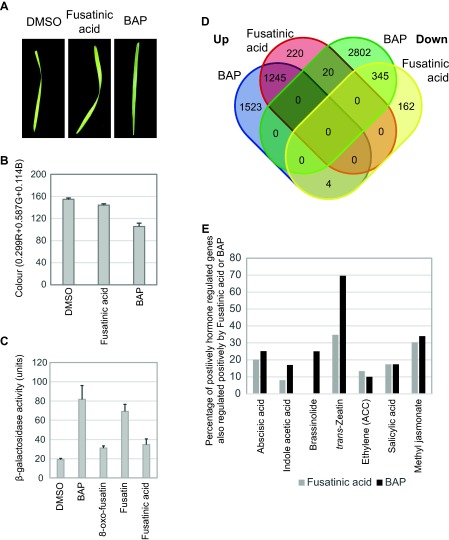Figure 5.

Fusarium cytokinin molecules have cytokinin activity. (A) Examples of gross effects of fusatinic acid and BAP (6‐benzyl aminopurine) treatment on detached Brachypodium leaves. Leaves were treated in 15 mL of 0.1% agarose with 10 μm of the hormone for 10 days on a laboratory bench. Dimethylsulfoxide (DMSO) (0.2% final concentration) was used as a control. (B) Relative leaf colour following treatment with fusatinic acid or BAP in Brachypodium, measured as the average red, green and blue pixel contents per unit leaf area. Lower numbers indicate darker leaves. The data consist of a minimum of 10 individual leaves per treatment with DMSO, fusatinic acid or BAP. (C) Fusarium cytokinins can activate the Arabidopsis histidine kinase 3 cytokinin receptor in a bacterial assay system. (D) RNA sequencing (RNAseq) analysis of gene expression changes in Brachypodium in response to BAP and fusatinic acid. Overlap between global gene expression changes in each treatment. All included genes were statistically significantly differentially regulated at P = 0.05 after Benjamini–Hochberg false discovery correction. (E) Overlap between the fusatinic acid or BAP positively regulated genes and the high‐stringency hormone regulated gene sets defined by Kakei et al. (2015). The positively hormone regulated high‐stringency gene sets contained the following numbers of genes: abscisic acid, 423; indole acetic acid, 112; brassinolide, 4; trans‐zeatin, 23; salicylic acid, 52; methyl jasmonate, 362. The overlap presented for ethylene was based on the low‐stringency set from Kakei et al. (2015) as these authors found no gene differentially regulated by ethylene when high‐stringency filtering was applied. ACC, 1‐aminocyclopropane‐1‐carboxylic acid.
